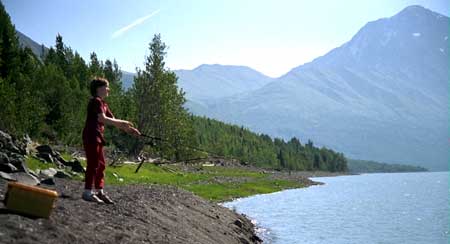Fishing in Alaska
Fishing in Alaska is a big subject because the fish available range all the way from hooligan to whales and fishing holes include streams, rivers, lakes, bays and the open ocean. Whale hunting is reserved for Natives on Alaska's North Slope, but other types of fishing are not so restricted. Fishermen's most popular targets are salmon (red, pink, silver, king and chum), freshwater and saltwater trout, and halibut. But there are other fish to choose from, too, including lingcod, rockfish, Dolly Varden, Arctic grayling, sheefish and northern pike. Fishing derbies during the summer in Seward, Valdez, Homer and Anchorage let winning fishermen go home with cash (as much as $50,000) as well as their catch.
The three most popular types of fishing in Alaska are combat, wilderness and deep sea fishing.
 Combat fishing is when anglers stand shoulder to shoulder-- or sit boat to boat -- during salmon runs on streams and rivers that are easily reached by road near Anchorage, Talkeetna or on the Kenai Peninsula. In fact, Ship Creek, just down the hill from downtown Anchorage, is a popular fishing spot. There's even an observation platform near a spillway that gives visitors a good view of salmon fighting their way upstream. Combat fishing is when anglers stand shoulder to shoulder-- or sit boat to boat -- during salmon runs on streams and rivers that are easily reached by road near Anchorage, Talkeetna or on the Kenai Peninsula. In fact, Ship Creek, just down the hill from downtown Anchorage, is a popular fishing spot. There's even an observation platform near a spillway that gives visitors a good view of salmon fighting their way upstream.
Wilderness fishing is for anglers who want to escape the crowds and are willing to spend a little money to do it. Fly-in fishing is the answer for folks who have only a day or two. A number of flying services will drop fishermen off at remote spots that are easily reached by floatplane and then pick them up when the fishing's done. A vacation at a wilderness lodge is the solution for those who want a more extended wilderness fishing trip.
Deep sea fishing is for those who want to go for the big one: halibut. For this, it's necessary to charter a boat at a port such as Homer, Seward, Valdez or Cordova and to head out into deep water. Halibut are bottom feeders that often weigh more than 100 pounds. Winners of the annual halibut fishing contests may weigh 300 pounds or more.
 |

 Combat fishing is when anglers stand shoulder to shoulder-- or sit boat to boat -- during salmon runs on streams and rivers that are easily reached by road near Anchorage, Talkeetna or on the Kenai Peninsula. In fact, Ship Creek, just down the hill from downtown Anchorage, is a popular fishing spot. There's even an observation platform near a spillway that gives visitors a good view of salmon fighting their way upstream.
Combat fishing is when anglers stand shoulder to shoulder-- or sit boat to boat -- during salmon runs on streams and rivers that are easily reached by road near Anchorage, Talkeetna or on the Kenai Peninsula. In fact, Ship Creek, just down the hill from downtown Anchorage, is a popular fishing spot. There's even an observation platform near a spillway that gives visitors a good view of salmon fighting their way upstream.
